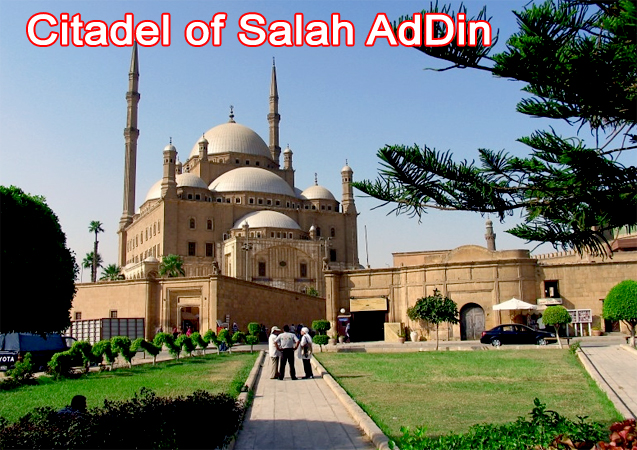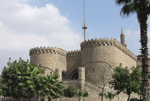Saladin Citadel Cairo — The Citadel of Saladin and Cairo’s Historic Fortress
The Saladin Citadel Cairo (also known as the Citadel of Saladin or Cairo Citadel) is a vast medieval fortress on Mokattam Hill. Built in the 12th century by Salah al-Din, it houses the iconic Mosque of Muhammad Ali, several museums, and breathtaking viewpoints. Plan half a day to explore its buildings, learn its layered history, and enjoy panoramic views of Cairo; sunset is particularly memorable.
Table of Contents
Saladin Citadel Cairo
The Saladin Citadel Cairo crowns Mokattam Hill like a watchful guardian. Its stone walls and defensive towers were once an imposing statement of military might today they form a layered complex of mosques, museums, and courtyards. From the Citadel you can see how Cairo unfolded around its walls: the river, crowded neighborhoods, and distant desert horizon. The site’s combination of architectural styles narrates centuries of politics, religion, and art.
Citadel of Saladin A Fortress with a Purpose
Known historically as the Citadel of Saladin, the fortress was commissioned by Sultan Salah al-Din (Saladin) after the Crusader period. Its strategic position allowed rulers to protect the city and control routes in and out of Cairo. Over time, successive dynasties expanded and embellished the complex Mamluks and Ottomans left their imprint in the fine details of mosques and palaces inside the Citadel.
Cairo Citadel The Heart of Medieval Authority
The term Cairo Citadel highlights the structure’s civic role: it was the seat of government for centuries. Emirs, governors, and sultans administered the region from within these walls. Today the Citadel functions as an open-air museum, where restored halls and exhibits allow visitors to step into the administrative and ceremonial life of pre-modern Cairo.
Citadel of Salah el din Names and Variations
Because different transliterations exist Citadel of Salah el din, Citadel of Salah el-din, and Citadel of Salah al-din you will see the same fortress referred to in many ways. All point to the same essential story: a defensive citadel that became a symbolic and spiritual center, evolving from a military outpost into a cultural landmark.
History and Purpose
Salah al-Din founded the Citadel in the late 12th century after he unified Egypt and fought the Crusaders. The early purpose was straightforward fortify Cairo and create a defensible royal enclosure. In the centuries that followed, rulers added palaces, grand mosques, and functional buildings for state matters. The Mamluk period (13th–16th centuries) saw the Citadel transformed into a sumptuous court, with fine architecture and artistic commissions celebrating power and piety.
Main Sights Inside the Citadel
Exploring the Citadel reveals a compact list of must-see attractions:
- Mosque of Muhammad Ali: The most visually dominant building, with twin minarets and an Ottoman-inspired dome a landmark often called the Alabaster Mosque.
- Al-Nasir Muhammad Mosque: A stunning Mamluk-era mosque with intricate marble work and a peaceful interior courtyard.
- Museums: The Military Museum and the Carriage Museum offer context about Egypt’s modern and pre-modern history.
- Governor’s Palace ruins & viewpoints: Walk the ramparts to find dramatic overlooks for photos, especially at golden hour.
Each building tells a different chapter: Ottoman grandeur in Muhammad Ali’s mosque, Mamluk artistry in Al-Nasir’s spaces, and modern narratives in the museums.
Visitor Tips & Practical Info
To get the most from your visit to the Citadel, consider these practical tips:
- Timing: Aim for late afternoon to combine cooler temperatures and a sunset view. The site can be windy on the hilltop, so bring a light jacket.
- Tickets: Entry typically requires a ticket; special sections and museums may have separate fees. Check opening hours before you travel.
- Guides: Hiring a local guide enriches the visit; they can explain the complex layers of history and point out architectural details you might miss.
- Comfort: Wear comfortable shoes the site has ramps, steps, and uneven stone surfaces.
Nearby Attractions & Internal Link
The Citadel sits within central Cairo and pairs well with nearby sites. After exploring the fortress, consider visiting the
Cairo Tower for a different panoramic perspective, or head into the historic streets to sample local cuisine and cafés. Combining the Citadel with a walk through nearby medieval neighborhoods gives a fuller sense of Cairo’s layered character.
Conclusion & External Reference
The Saladin Citadel Cairo remains an essential stop for anyone wanting to understand Cairo’s past and present. Its monuments, defensive geometry, and sweeping views make it a place of both study and reflection. For a concise historical overview and additional reference material, see
Citadel of Cairo Wikipedia.
Frequently Asked Questions
Where is the Citadel of Saladin located?
It is located on Mokattam (Mokattam Hill) overlooking central Cairo, offering strategic views across the city.
Can I enter and visit the Cairo Citadel museums?
Yes. The site includes museums such as the Military Museum and Carriage Museum; check seasonal opening times and entry fees.
Is the Mosque of Muhammad Ali inside the Citadel open to non-Muslim visitors?
Generally, non-Muslim visitors can enter the mosque outside prayer times; respectful dress is required and certain areas may be restricted during services.
How long should I plan for a visit?
Plan approximately 2–4 hours to see the main mosques, walk the ramparts, and visit at least one museum longer if you take a guided tour.





